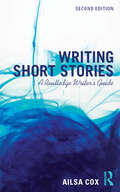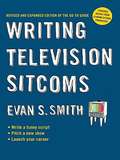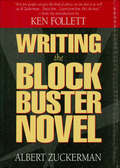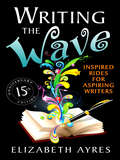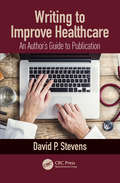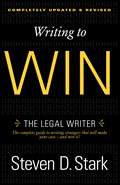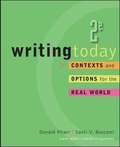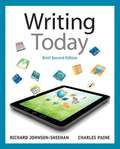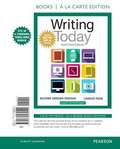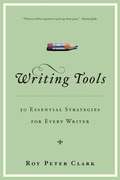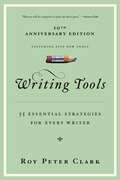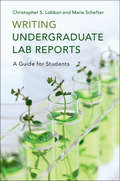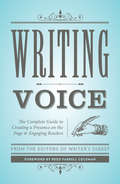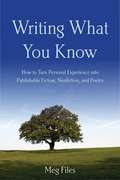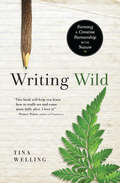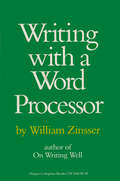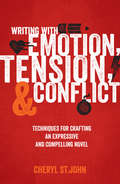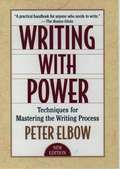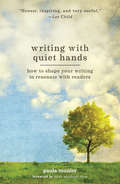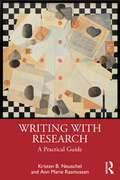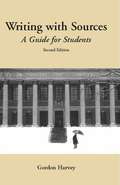- Table View
- List View
Writing Short Stories: A Routledge Writer's Guide
by Ailsa CoxThis new edition of Writing Short Stories has been updated throughout to include new and revised exercises, up-to-date coverage of emerging technologies and a new glossary of key terms and techniques. Ailsa Cox, a published short-story writer, guides the reader through the key aspects of the craft, provides a variety of case studies and examples of how others have approached the genre and sets a series of engaging exercises to help hone your skills. This inspiring book is the ideal guide for those new to the genre or for anyone wanting to improve their technique.
Writing Successful Science Proposals: Third Edition
by Andrew J. Friedland Carol L Folt Jennifer L. MercerAn authoritative how-to guide that explains every aspect of science proposal writing This fully revised edition of the authoritative guide to science proposal writing is an essential tool for any researcher embarking on a grant or thesis application. In accessible steps, the authors detail every stage of proposal writing, from conceiving and designing a project to analyzing data, synthesizing results, estimating a budget, and addressing reviewer comments and resubmitting. This new edition is updated to address changes and developments over the past decade, including identifying opportunities and navigating the challenging proposal funding environment. The only how-to book of its kind, it includes exercises to help readers stay on track as they develop their grant proposals and is designed for those in the physical, life, environmental, biomedical, and social sciences, as well as engineering.
Writing Television Sitcoms (revised)
by Evan S. SmithNew edition of the popular screenwriting guide! Writing Television Sitcoms is the ultimate all-in-one guide to writing a funny script, pitching a new show, and launching a successful career. AS digital technology reshapes the television industry, this new and expanded edition explains how today's writers can get ahead of the curve. Features include: ? A complete description of premise-driven comedy, a proven method for "writing funny from the ground up" ? Numerous examples from new and classic shows ? Advice from top writer-producers ? A thorough look at how sitcom story models are changing ? Complete script layout guidelines for all three formats ? Tips on how new-media developments can help you break into the business
Writing the Blockbuster Novel
by Al ZuckermanEvery novelist dreams of it--writing the book that rockets to the top of the best-seller lists. Now, they can see how it's done, up close, in a book by an agent who has sold manuscripts that turned into hits.<P><P> Here Albert Zuckerman covers the essential elements of the blockbuster novel and shows writers how to put them to work in their books. Zuckerman covers the subject thoroughly, from creating outlines and building larger than life characters to injecting suspense and more. His instruction is decisive, direct and clear and is supported with examples from Gone With the Wind, The Godfather and other blockbusters.
Writing the Paranormal Novel: Techniques and Exercises for Weaving Supernatural Elements into Your Story
by Steven HarperVampires, werewolves, and zombies, oh my!Writing a paranormal novel takes more than casting an alluring vampire or arming your hero with a magic wand. It takes an original idea, believable characters, a compelling plot, and surprising twists, not to mention great writing. This helpful guide gives you everything you need to successfully introduce supernatural elements into any story without shattering the believability of your fictional world or falling victim to common cliches. You'll learn how to:Choose supernatural elements and decide what impact the supernatural will have on your fictional worldCreate engaging and relatable characters from supernatural protagonists and antagonists to supporting players (both human and non-human)Develop strong plots and complementary subplotsWrite believable fight scenes and flashbacksCreate realistic dialogueAnd much moreComplete with tips for researching your novel and strategies for getting published, Writing the Paranormal Novel gives you everything you need to craft a novel where even the most unusual twist is not only possible-it's believable.
Writing the Wave: Inspired Rides for Aspiring Writers
by Elizabeth AyresWhere's your wave of creativity? If you want to learn how to write, "Writing the Wave: Inspired Rides for Aspiring Writers" is the very first writing book designed especially for beginning writers who yearn to write more expressively. Written with warmth and wit by internationally acclaimed writer and teacher Elizabeth Ayres, this 15th anniversary edition of a classic writing how-to book makes the creative process safe, easy and fun while honoring its spiritual depth and mystery. Elizabeth shows you how it's done. With step-by-step instructions and easy-to-follow writing exercises, you'll be writing non-stop from the very first page, even if you've never written before. It's just like having a personal writing coach. You can learn how to be a writer. Throw away those endless lists of writing prompts. Learn how to discover your own ideas with these break-through writing exercises that transform fundamental writing principles into concrete writing techniques you can use over and over, forever, whether you want to learn how to write fiction, nonfiction, poetry -- or something that doesn't even have a name yet. Unlike other writing books, "Writing the Wave" couples inspiring writing exercises with expert and compassionate advice, to minimize the fears and maximize the joys of writing. And more advanced writers looking for a jumpstart will appreciate recovering their free-flowing creative wellspring. There's a vast ocean of inspiration within you. The surf's up! The water's warm! Are you ready to take the plunge? "Elizabeth Ayres has thought long and hard about the writing process, and is one of the most seasoned and exemplary practitioners in the field of teaching writing. This book about writing is an invaluable distillation of her insights and experiences. I cannot imagine any beginning or struggling writer not coming away with some inspiration from it." (Phillip Lopate, editor of "The Art of Writing" and "Writing New York")
Writing to Improve Healthcare: An Author’s Guide to Scholarly Publication, First Edition
by David P. StevensThis new book is a 'what and how to' guide to writing for successful scholarly publication in the emerging fields of healthcare improvement and patient safety. While there are many useful authors’ aids for scholarly biomedical publication, none focuses explicitly on these relatively new fields. It offers practical advice that includes preparation and organization of a scholarly healthcare improvement manuscript, where to submit it to find the most likely interested editor and journal, how to take full advantage of coauthors’ working together effectively, and strategies for authors to reach a broader health professions readership.
Writing to Win: The Legal Writer
by Steven D. StarkFrom a master teacher, a results-oriented approach to powerful legal writing that communicates, that persuades--and that wins.Of all the professions, the law has the most deserved reputation for opaque, jargon-clogged writing. Legal education, which focuses on judicial opinions, not instruments of persuasion, is partly to blame. Yet forceful writing is one of the most potent weapons of legal advocacy. In Writing to Win, Steve Stark, a former teacher of writing at Harvard Law, who has taught thousands of aspiring and practicing lawyers, has written the only book on the market that applies the universal principles of vigorous prose to the job of making a case--and winning it.Writing to Win focuses on the writing of lawyers, not judges, and includes dozens of examples of effective (and ineffective) real-life writing--as well as models drawn from advertising, journalism, and fiction. It deals with the problems lawyers face in writing, from organization to strengthening and editing prose; teaches ways of improving arguments; addresses litigation and technical writing in all its forms; and covers the writing attorneys must perform in their practice, from memos and letters to briefs and contracts. Each chapter opens with a succinct set of rules for easy reference.No other legal writing book on the market is as practical, as focused on results, as well written as Writing to Win.From the Trade Paperback edition.
Writing Today: Contexts and Options for the Real World (2nd edition)
by Donald Pharr Santi BuscemiWriting Today begins with a chapter helping students learn the skills they will need to thrive throughout college and continues to promote reading and writing as practical tools both in college and in the work world. Full chapters on Group Projects and Oral Presentations teach students how to not only be successful in the classroom, but in the world of work as well. Students are sure to be engaged as they focus on the both the academic and professional contexts of writing.
Writing Today (Brief Edition)
by Richard Johnson-Sheehan Charles PaineWith a clear and easy-to-read presentation, visual instruction and pedagogical support, Writing Today is a practical and useful guide to writing for college and beyond. This text teaches how to transfer their writing skills to careers. By teaching kinds of writing (analyses, reports, proposals, etc. ), strategies for writing (narration, comparison, argumentation, etc. ), and processes for writing (planning, drafting, revising, etc. ), Writing Today provides the writer with tools they can mix and match as needed to respond effectively to many writing situations.
Writing Today (Brief Third Edition)
by Richard Johnson-Sheehan Charles PaineThis version of Writing Today, Brief Edition has been updated to reflect the 8th edition of the MLA Handbook (April 2016). The 8th edition introduces sweeping changes to the philosophy and details of MLA works cited entries. Responding to the “increasing mobility of texts,” MLA now encourages writers to focus on the process of crafting the citation, beginning with the same questions for any source. These changes, then, align with current best practices in the teaching of writing which privilege inquiry and critical thinking over rote recall and rule-following. <p><p> Accessible to students and flexible for instructors, Writing Today, Brief Edition, Third Edition introduces students to the conventions of writing memoirs, profiles, literary analyses, arguments, research papers, and more. Each chapter features a step-by-step process for composing within a given genre, as well as exemplary student and professional readings to promote rhetorical knowledge and critical analysis. The 32 short chapters, the chunked writing style, and visual instruction work to ensure that students will transfer the skills and strategies practiced in your class to their other classes, their lives, and their careers. From its graphic “Quick Start Guides” to its “Write This” prompts, Writing Today, Brief Edition challenges students to extend the boundaries of their writing abilities as they practice composing for the real world.
Writing Tools: 50 Essential Strategies for Every Writer
by Roy Peter ClarkWriting Tools covers everything from the most basic tool to the more complex ones and provides more than 200 examples from literature and journalism to illustrate the concepts.
Writing Tools: 55 Essential Strategies for Every Writer
by Roy Peter ClarkOne of America's most influential writing teachers offers a toolbox from which writers of all kinds can draw practical inspiration."Writing is a craft you can learn," says Roy Peter Clark. "You need tools, not rules." His book distills decades of experience into 50 tools that will help any writer become more fluent and effective. WRITING TOOLS covers everything from the most basic ("Tool 5: Watch those adverbs") to the more complex ("Tool 34: Turn your notebook into a camera") and provides more than 200 examples from literature and journalism to illustrate the concepts. For students, aspiring novelists, and writers of memos, e-mails, PowerPoint presentations, and love letters, here are 50 indispensable, memorable, and usable tools. "Pull out a favorite novel or short story, and read it with the guidance of Clark's ideas. . . . Readers will find new worlds in familiar places. And writers will be inspired to pick up their pens." -Boston Globe"For all the aspiring writers out there-whether you're writing a novel or a technical report-a respected scholar pulls back the curtain on the art." -Atlanta Journal-Constitution"This is a useful tool for writers at all levels of experience, and it's entertainingly written, with plenty of helpful examples." -Booklist
Writing Undergraduate Lab Reports: A Guide for Students
by Lobban Christopher S. María SchefterWriting clear, impactful reports is a crucial skill for science students, but few books focus on this area for the undergraduate. Particularly useful for biology students, this text adopts a hands-on approach, using example reports and published papers as models to put guidance into practice. An introductory chapter familiarizes undergraduates with the principles of writing science. Two model reports are then developed, walking students through experimental and observational teaching-lab reports. The structure and content of the Introduction, Methods and Materials, Results, and Discussion are explained, together with tips for the title, abstract, and references. Students are then guided on how to polish their first draft. The last section of the book analyzes two published papers, helping the reader transition to reporting original research. Clearly and concisely written, this text offers a much-needed lifeline for science students facing science report-writing for the first time, and for those looking to hone their writing skills.
Writing Voice: The Complete Guide to Creating a Presence on the Page and Engaging Readers (Creative Writing Essentials)
by Cris FreeseThe Complete Guide to Creating a Presence on the Page & Engaging Readers
Writing What You Know: How to Turn Personal Experiences into Publishable Fiction, Nonfiction, and Poetry
by Meg FilesIt's easy for people to write about their feelings in a journal. It's more difficult, however, to convert personal experiences into stories worthy of publication-fiction, non-fiction, or poetry. Filled with engaging exercises, Write from Life guides writers in identifying story-worthy material and transforming their raw material into finished pieces, through conquering fears associated with personal exposure, determining a story's focus, shaping the material into a cohesive whole, and editing and revising as needed. Writers working in any form will find this book invaluable for supplying them with the inspiration and practical instruction they need to get their experiences and emotions into print. In addition, they will learn to:Tap into difficult, guarded parts of their lives to tell the stories they desireWrite emotionally intense materialDecide which literary form is right for their storiesCreate the illusion of real speech with effective dialogueTell their stories with authorityDevelop effective beginnings, middles, and endsShare their work with others and deal with reactions courageouslyFiles' friendly, encouraging advice makes it a pleasure for writers to write the stories they are most passionate about. In an age when publishing can mean pushing a button on Facebook, Twitter, or a blog, there is an enduring urge to send stories out into the world. In an atmosphere of misinformation and lies that social media and the ease of publishing may encourage, we especially crave truth. The time to start telling it is now-so many aspiring writers have truths worth sharing and stories begging to be told!Allworth Press, an imprint of Skyhorse Publishing, publishes a broad range of books on the visual and performing arts, with emphasis on the business of art. Our titles cover subjects such as graphic design, theater, branding, fine art, photography, interior design, writing, acting, film, how to start careers, business and legal forms, business practices, and more. While we don't aspire to publish a New York Times bestseller or a national bestseller, we are deeply committed to quality books that help creative professionals succeed and thrive. We often publish in areas overlooked by other publishers and welcome the author whose expertise can help our audience of readers.
Writing Wild: Forming a Creative Partnership with Nature
by Tina WellingAlign Your Creative Energy with Nature’s “Everything we know about creating,” writes Tina Welling, “we know intuitively from the natural world.” In Writing Wild, Welling details a three-step “Spirit Walk” process for inviting nature to enliven and inspire our creativity.
Writing with a Word Processor
by William ZinsserIn this helpful and entertaining book the author of the classic On Writing Well explains that he has always had a love of paper and a fear of mechanical objects. He describes how he confronted his hang-ups, got a word processor, taught himself to use it and gradually overcame his sense of inferiority to the machine. He explains how the word processor--by enabling him to revise his work instantly on a screen--has changed his lifelong methods of writing, rewriting and editing.But William Zinsser's book isn't only for writers. It's for all the people who have to do any kind of writing--memos, letters, reports, directives--as part of their working day. It explains how the word processor will save time and money in an office or a corporation and predicts that it will soon be our primary writing tool.On one level Writing with a Word Processor is a manual for beginners that describes clearly and simply how to use the new technology. But it is also one writer's story. William Zinsser takes the reader along on a highly personal journey, writing with warmth and humor about his anxieties and fears, his setbacks and triumphs. His book is both an informal guide and an encouraging companion.
Writing with Confidence: Writing Effective Sentences and Paragraphs
by Alan MeyersWriting With Confidence, a value-priced developmental writing book, provides essential instruction and practice in basic writing skills at the sentence and paragraph level. The first developmental book to include incorporate high-interest, connected discourse subject matter in its exercises,Writing with Confidenceretains and expands on this feature. Most chapters pursue a theme throughout the exercises-the dreams and premonitions surrounding the death of Abraham Lincoln; animal facts and oddities; the gustatory achievements of Diamond Jim Brady, the world's greatest eater; the voyage of the Kon-Tiki; and so on. The text's six-unit structure includes thirty short chapters on the writing process, paragraph organization and development, the shape of the essay, all the rhetorical modes, and all the sentence skills. The writing chapters are fully process oriented, showing the development of a paragraph in six steps, from planning and outlining through drafting, revising, editing, and proofreading. Optional collaborative activities are provided in the margins of each chapter. This focus on writing is balanced with equal attention to sentence skills, not only for native speakers of English who need help, but for non-English-dominant speakers as well. ESL boxes provide help for readers whose first language is not English, as do the two final chapters of the book, which address troublesome matters such as verb phrases, word order, articles, and prepositions. The reading-writing connection throughout the book has been expanded, with sixteen additional readings in the last unit of the book. And the popular "Blueprints for Writing" found in the rhetorical chapters have been carried into unit ending "Blueprints for Success," in which the most important concepts and practices are summarized in graphs and charts. For those seeking to develop their writing skills at the sentence to paragraph level.
Writing With Emotion, Tension, and Conflict: Techniques for Crafting an Expressive and Compelling Novel
by Cheryl St. JohnToday's highly competitive fiction market requires writers to imbue their novels with that special something - an element that captures readers' hearts and minds. In Writing With Emotion, Tension & Conflict, writers will learn vital techniques for writing emotion into their characters, plots and dialogue in order to instill that special something into every page.
Writing with Power: Techniques for Mastering the Writing Process,Second Edition
by Peter ElbowEmploying a cookbook approach, Elbow provides the reader (and writer) with various recipes: for getting words down on paper, for revising, for dealing with an audience, for getting feedback on a piece of writing, and still other recipes for approaching the mystery of power in writing. In a new introduction, he offers his reflections on the original edition, discusses the responses from people who have followed his techniques, how his methods may differ from other processes, and how his original topics are still pertinent to today's writer. By taking risks and embracing mistakes, Elbow hopes the writer may somehow find a hold on the creative process and be able to heighten two mentalities--the production of writing and the revision of it.
Writing With Quiet Hands: How to Shape Your Writing to Resonate with Readers
by Paula MunierCommit to Your Writing Craft!To write with quiet hands is to embrace the journey all writers must take: from seeking inspiration and shaping raw material to cultivating a personal support network, navigating the various pathways to publication, and committing to a lifelong practice. In Writing with Quiet Hands, author and literary agent Paula Munier helps you hone your words into well-crafted stories and balance this satisfying work with the realities and challenges of the publishing world.You'll learn how to tame your muse, manage your time wisely, and treat your practice with the seriousness it deserves. You'll develop a distinct voice, write with style and substance, employ the tenets of strong structure, and engage your readers by injecting narrative thrust into your stories. You'll explore the finer aspects of craft, refine your work, and boldly bridge the gap between published and unpublished. From drafting and revising to querying agents, you'll discover the secrets to writing artfully, and publishing bravely.Fulfilling and rewarding writing careers are forged from the successful marriage of craft and business know-how. Are you ready to embark on your journey, armed with both grace and grit? Are you ready to write with quiet hands?"Writing with Quiet Hands is loaded tips and tools, firsthand experience, and down-to-earth advice from a writer, editor, and agent who's seen it from all sides. Paula Munier gives it to you straight as she dissects the inspiration, perspiration, and dogged determination it takes to set and meet your writing goals. This book will keep you sane." --Hallie Ephron, New York Times best-selling author of Night Night, Sleep Tight
Writing with Research: A Practical Guide
by Kristen B. Neuschel Ann Marie RasmussenWriting with Research offers readers practical guidance for managing writing and research as combined tasks. Kristen B. Neuschel and Ann Marie Rasmussen bring expert advice from their extensive experience as writers, researchers, and teachers, making this an indispensable, user-friendly guide to research-based writing.This book describes how to launch writing and researching together and how to continue the work as an iterative, not linear, process. It explores the challenges of finding time for writing and research, and offers tips on how to make progress, even in short writing and researching sessions. It describes the steps necessary for responsible research in the contemporary digital environment, including the role Artificial Intelligence might play and how to map arguments as they emerge through writing. This book offers readers the tools to confront stumbling blocks like procrastination. It shows the benefits of building writing communities and how to make use of feedback at various stages of a project.The short and easily digestible chapters make this a go-to resource for a wide audience, from students, professors, and scientists to professionals. Writing with Research helps all researchers find the resources they need to be successful and encourages them to think of themselves as writers, now and into the future.
Writing With Sources: A Guide For Students 2nd Edition
by Gordon HarveyDeveloped for Harvard University's Expository Writing Program, Writing with Sources describes the main principles and methods of integrating and citing sources in scholarly work, and provides cogent guidance on avoiding the misuse of sources. The second edition of Writing with Sources is updated throughout, and includes new material on the roles sources play in argument, on assessing the reliability of sources, and on attitudes about writing that can lead to plagiarism.
